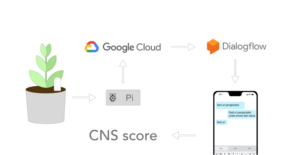Exploring human plant interaction is something that has always intrigued me. This is why I wrote my master thesis on this topic. I started mapping out the possibilities and came up with a prototype that was not only used for user testing and figuring out the guiding principles of conversational interfaces with plants, but was also used as a research tool that measures the users connectedness to plants after interacting with the prototype.
Abstract:
Several studies reveal that the presence of plants in our environment can provide multiple benefits for a person’s physical and mental health. Ecopsychologists even argue humans have an undeniable connection with nature. Yet, we do not always seem to understand plants and often tend to neglect our houseplants. This research proposes a proof of concept in which plants are connected to a conversational interface to improve the relationship we have with them. Using sensors and a database of a plant’s optimal needs, a chatbot can be made that communicates in natural language. This study proposes several design guidelines for designing conversational interfaces that enable human plant interaction.
Full text
Design principles:
1. Begin with a clear onboarding
2. Let the user choose who they are talking to (character creation)
3. Do not overuse emotional language
4. Use cards, images and checklists
5. Clearly communicate what is possible
6. Give an immediate response (using real time data)
